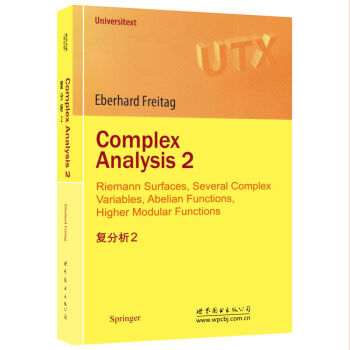![量子群入门 [A Guide to Quantum Groups]](https://pic.windowsfront.com/10184614/52569431-fb1f-4b41-9463-fd47031ffa99.jpg)

具体描述
内容简介
quantum groups first arose in the physics literature, particularly in the work of L. D. Faddeev and the Leningrad school, from the inverse scattering method, which had been developed to construct and solve integrable quantum systems. They have excited great interest in the past few years because of their unexpected connections with such, at first sight, unrelated parts of mathematics as the construction of knot invariants and the representation theory of algebraic groups in characteristic p.In their original form, quantum groups are associative algebras whose defin-ing relations are expressed in terms of a matrix of constants (depending on the integrable system under consideration) called a quantum R-matrix. It was realized independently by V. G. Drinfeld and M. Jimbo around 1985 that these algebras are Hopf algebras, which, in many cases, are deformations of universal enveloping algebras of Lie algebras. A little later, Yu. I. Manin and S. L. Woronowicz independently constructed non-commutative deforma-tions of the algebra of functions on the groups SL2(C) and SU2, respectively,and showed that many of the classical results about algebraic and topological groups admit analogues in the non-commutative case.
作者简介
作者:(美国)沙里(Chari.V.)内页插图
目录
Introduction1 Poisson-Lie groups and Lie bialgebras
1.1 Poisson manifolds
A Definitions
B Functorial properties
C Symplectic leaves
1.2 Poisson-Lie groups
A Definitions
B Poisson homogeneous spaces
1.3 Lie bialgebras
A The Lie bialgebra of a Poisson-Lie group
B Martintriples
C Examples
D Derivations
1.4 Duals and doubles
A Duals of Lie bialgebras and Poisson-Lie groups
B The classical double
C Compact Poisson-Lie groups
1.5 Dressing actions and symplectic leaves
A Poisson actions
B Dressing transformations and symplectic leaves
C Symplectic leaves in compact Poisson-Lie groups
D Thetwsted ease
1.6 Deformation of Poisson structures and quantization
A Deformations of Poisson algebras
BWeylquantization
C Quantization as deformation
Bibliographical notes
2 Coboundary PoissoI-Lie groups and the classical Yang-Baxter equation
2.1 Coboundary Lie bialgebras
A Definitions
B The classical Yang-Baxter equation
C Examples
D The classical double
2.2 Coboundary Poisson-Lie groups
A The Sklyanin bracket
B r-matrices and 2-cocycles
CThe classicalR-matrix
2 3 Classical integrable systems
A Complete integrability
B Lax pairs
C Integrable systems from r-matrices
D Toda systems
Bibliographical notes
3 Solutions of the classical Yang-Baxterequation
3.1 Constant solutions of the CYBE
A The parameter space of non.skew solutions
B Description of the solutions
C Examples
D Skew solutions and quasi-Frobenins Lie algebras
3.2 Solutions of the CYBE with spectral parameters
A Clnssification ofthe solutions
B Elliptic solutions
C Trigonometrie solutions
D Rational solutions
B ibliographical notes
4 Quasitriangular Hopf algebras
4.1 Hopf algebras
A Definitions
B Examples
C Representations of Hopf algebras
D Topological Hopf algebras and duMity
E Integration Oll Hopf algebras
F Hopf-algebras
4.2 Quasitriangular Hopf algebras
A Almost cocommutative Hopf algebras
B Quasitriangular Hopf algebras
C Ribbon Hopf algebras and quantum dimension
D The quantum double
E Twisting
F Sweedler8 example
Bibliographical notes
5 Representations and quasitensor categories
5.1 Monoidal categories
A Abelian categories
B Monoidal categories
C Rigidity
D Examples
E Reconstruction theorems
5.2 Quasitensor categories
ATensorcategories
B Quasitensor categories
C Balancing
D Quasitensor categories and fusion rules
EQuasitensorcategoriesin quantumfieldtheory
5.3 Invariants of ribbon tangles
A Isotopy invariants and monoidal functors
B Tangleinvariants
CCentral ek!ments
Bibliographical notes
6 Quantization of Lie bialgebras
6.1 Deformations of Hopf algebras
A Defmitions
B Cohomologytheory
CIugiditytheorems
6.2 Quantization
A(Co-)Poisson Hopfalgebras
B Quantization
C Existence of quantizations
6.3 Quantized universal enveloping algebras
ACocommut&tiveQUE; algebras
B Quasitriangular QUE algebras
CQUE duals and doubles
D The square of the antipode
6.4 The basic example
A Constmctmn of the standard quantization
B Algebra structure
C PBW basis
D Quasitriangular structure
ERepresentations
F A non-standard quantization
6.5 Quantum Kac-Moody algebras
A The-andard quantization
B The centre
C Multiparameter quantizations Bibliographical notes
7 Quantized function algebras
7.1 The basic example
A Definition
B A basis of.fn(sL2(c))
C TheR-matrixformulation
D Duality
E Representations
7.2 R-matrix quantization
A From It-matrices to bialgebras
B From bialgebras to Hopf algebras:the quantum determinant
C solutions oftheQYBE
7.3 Examples of quantized function algebras
A The general definition
B The quantum speciallinear group
C The quantum orthogonal and symplectic groups
D Multiparameter quantized function algebras
7.4 Differential calculus on quantum groups
A The de Rham complex ofthe quantum plane
BThe deRham complex ofthe quantum m×m matrices
CThedeRhamcomplex ofthe quantum generallinear group
DInvariantforms on quantumGLm
7.5 Integrable lattice models
AVertexmodels
BTransfermatrices
……
9 Specializations of QUE algebras
10 Representations of QUE algebas the generic case
11Representations of QUE algebas the root of unity case
12 Infinite-dimensionalquantum groups
13 Quantum harmonic analysis
14 Canonical bases
15 Quantum gruop invariants f knots and 3-manifolds
16 Quasi-Hopf algebras and the Knizhnik -Zamolodchikov equation
前言/序言
用户评价
这本书的装帧风格十分考究,散发着一种严谨而又不失艺术感的学术气息。我对量子群的了解仅限于一些模糊的科普读物,知道它是一种广义的群结构,在理论物理中有着重要的应用。我迫切地希望通过这本书,能够系统地学习量子群的基本数学框架,理解其代数定义、算子代数以及相关的表示论。我特别关注书中是否能解释清楚量子群的“量子”和“群”这两个概念是如何结合的,以及它与我们熟悉的经典群有何本质区别。如果书中能够提供一些具体的数学例子,比如介绍一些常见的量子群的结构,并展示如何进行运算,那我将非常感激。同时,我也对它在物理学中的应用非常感兴趣,比如它在解决哪些经典物理学难题时提供了新的视角,或者在构建新的物理模型时起到了关键作用。我希望这本书能够在我现有的物理学知识基础上,为我打开一扇通往更深层次理解的大门,让我能够更好地理解那些前沿的物理理论。
评分这本书的封面设计就充满了神秘感,黑色的背景上用简洁的银色字体勾勒出“量子群入门”几个大字,仿佛直接指向了未知的宇宙深处。拿到手里,沉甸甸的,厚厚的书页预示着它并非一本轻松的读物,但正是这种厚重感,让我对即将展开的探索充满了期待。我一直对那些能够改变我们理解世界基础的理论着迷,从相对论到量子力学,每一次的突破都像是为人类打开了一扇新的大门。量子群,这个名字本身就带着一种抽象而迷人的魅力,它暗示着一种超越我们日常经验的数学结构,一种可能蕴藏着更深刻物理规律的钥匙。我希望这本书能够带领我,一个对量子群知之甚少的初学者,一步步深入其精妙的数学世界,理解其核心概念,感受它的理论力量。我期待着书中能够有清晰的逻辑脉络,从最基础的定义开始,循序渐进地引导我理解那些复杂的符号和抽象的结构。我希望它不仅仅是理论的堆砌,更能通过生动的例子和类比,帮助我建立直观的理解。毕竟,像量子群这样的高级概念,如果没有恰当的引导,很容易让人望而却步。这本书的“入门”二字,给了我很大的信心,相信它会是一个友好的向导,而不是冰冷的教科书。
评分当我拿到《量子群入门》这本书时,一种探索未知领域的兴奋感油然而生。这本书的纸张触感很好,印刷清晰,扉页上简洁的排版传递出一种专业的气息。我一直对数学和物理学的交叉领域非常着迷,而量子群正是这样一个融合了抽象代数和深刻物理思想的迷人领域。我希望这本书能够为我提供一个清晰的框架,让我能够理解量子群的数学本质。我期待着书中能够详细介绍量子群的定义,包括其双代数结构、Hopf代数性质以及其与表示论的紧密联系。如果书中能够包含一些关于量子群分类、特定量子群构造(如杨-Baxter方程与量子群的关系)的介绍,那将大大提升我的理解层次。我特别希望能看到书中如何将这些抽象的数学概念与具体的物理现象联系起来,比如它在统计力学、量子信息理论中的应用,或者在某些量子场论中的角色。对我而言,一本好的入门书不仅要讲清楚“是什么”,更要能够触及“为什么”和“能做什么”。
评分这本《量子群入门》给我最大的感受,就是它仿佛一座宏伟的数学殿堂的入口。翻开书页,扑面而来的不是枯燥的公式堆砌,而是一种精心设计的引导,让我感觉到作者是真正站在读者的角度,试图将一个极其抽象的概念具象化。我尤其欣赏书中在介绍基础概念时所采用的类比和可视化手法,例如,当提到“代数结构”时,书中似乎用了一种非常巧妙的比喻,让我能够从已知的数学对象中找到一丝联系,这对于理解量子群的非交换性等关键特征非常有帮助。虽然我还没有深入到书中的所有细节,但仅从前几章的铺垫来看,我感觉它是有意图地构建一种“直觉”的桥梁,而不是强迫读者去死记硬背定义。我期待着随着阅读的深入,能够逐渐掌握量子群的核心代数运算,理解其与图论、辫子群等其他数学分支的关联,甚至能够窥见它在量子信息、拓扑量子场论等前沿领域的应用前景。这本书的“入门”二字,并非意味着内容的浅薄,而是指引着一条通往深邃理论的清晰路径。
评分我选择这本书,完全是被它的标题所吸引。“量子群”,这个词汇本身就充满了前沿的科学气息,让我联想到那些最深刻的物理理论和最尖端的数学工具。我并非数学专业出身,但一直对物理学有着浓厚的兴趣,尤其是那些能够解释宇宙奥秘的理论。近年来,“量子群”这个概念在一些关于高维理论、量子引力甚至某些凝聚态物理的研究中频繁出现,这让我感到非常好奇,想要了解它到底是什么,以及它在现代物理学中扮演着怎样的角色。我希望这本书能够用相对易懂的方式,解释清楚量子群的基本构造和性质,比如它的代数结构、表示论等方面。我特别期待书中能够解答一些我脑海中浮现的问题,例如,量子群是如何与已有的数学框架(如群论、代数)联系起来的?它在解决哪些具体的物理问题上具有优势?是否会涉及到一些具体的数学推导过程,但又不会过于艰深,能够让我这种非专业读者也能够大致理解其思路?当然,如果书中能够穿插一些历史发展的脉络,介绍量子群的提出背景和重要里程碑,那将是锦上添花,让我更能体会到这项理论的价值。
评分说是入门,难度却不小,不过书是好书
评分很好
评分书的质量很好,内容很难
评分很好
评分这方面经典的了,买来看看和收藏都是不错的
评分数学物理工作者的好书。印刷质量很好。开本有点小。
评分很好的书啊很好的书啊
评分这方面经典的了,买来看看和收藏都是不错的
评分tinghaode
相关图书
本站所有内容均为互联网搜索引擎提供的公开搜索信息,本站不存储任何数据与内容,任何内容与数据均与本站无关,如有需要请联系相关搜索引擎包括但不限于百度,google,bing,sogou 等
© 2025 book.coffeedeals.club All Rights Reserved. 静流书站 版权所有




![线性代数群 [Linear Algebraic Groups] pdf epub mobi 电子书 下载](https://pic.windowsfront.com/10857737/fcb2f257-227e-43db-bed7-c73076c42824.jpg)
![经典物理学丛书(影印版):简明统计力学 [Statistical Mechanics in a Nutshell] pdf epub mobi 电子书 下载](https://pic.windowsfront.com/11316302/rBEhU1I4U_oIAAAAAAI69WH8VOoAADQsAOJkQ4AAjsN983.jpg)
![初等数列研究与欣赏(上) [Primary Sequence Study and Appreciation] pdf epub mobi 电子书 下载](https://pic.windowsfront.com/11879285/56e7d759Nb9bfd2cf.jpg)
![除尘工程技术手册 [Handbook on Dust Removal Engineering Techology] pdf epub mobi 电子书 下载](https://pic.windowsfront.com/11920147/5739c28cNcdf78f19.jpg)

![紧复曲面(第2版) [Compact Complex Surfaces(Second Enlarged Edition)] pdf epub mobi 电子书 下载](https://pic.windowsfront.com/10904479/29188fd0-2c57-4e1e-8b2f-1f3d4b31bce4.jpg)

![化归与归纳·类比 联想(珍藏版) [Reduction And Induction Analogy Association] pdf epub mobi 电子书 下载](https://pic.windowsfront.com/11883761/56f8fee3Nc9f86c4f.jpg)
![超对称和弦论(英文版) [Supersymmetry and String Theory] pdf epub mobi 电子书 下载](https://pic.windowsfront.com/10184594/e5b89bc9-3b3b-4fad-8861-ede9b682c51f.jpg)


![经典数学丛书(影印版):多元微积分教程 [A Course in Multivariable Calculus and Analysis] pdf epub mobi 电子书 下载](https://pic.windowsfront.com/11551553/5438761dNe141b59b.jpg)




